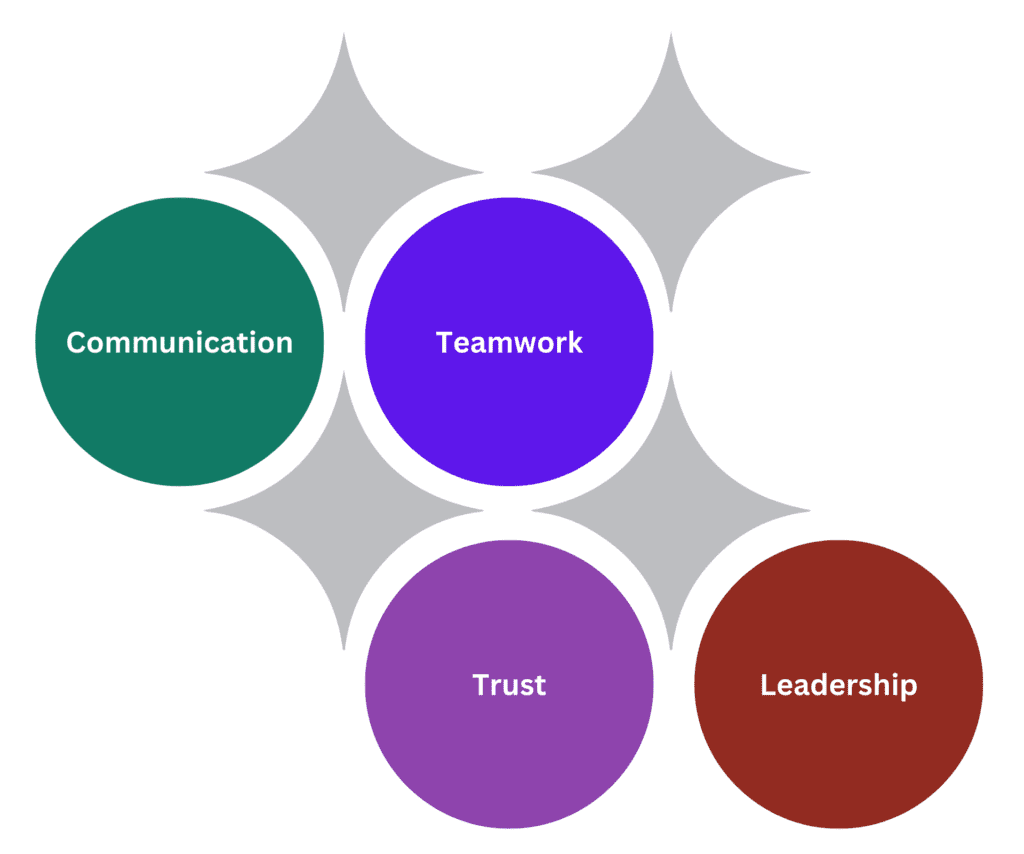
CHAPTER 7
In order to work together, people must get to know each other. Often, we imagine that the simple fact that they are colleagues, that they work together, that they have a common task, would be enough for the participants to know each other. This is not true! Often, tasks, projects, unfold for months until the young people from the same year of study, or the people from the respective work team, come to feel comfortable with each other and the group’s productivity reaches an optimal level.
Introductory games serve the mutual acquaintance of people who come to work in new environments or groups, or to remind them of who they work with – those from the old groups.
The aim is to relax the participants.
For forced socialisation of players who know each other little or not at all, the following games can be used:
7.1. First Contact with Players

When the participants gather and it’s time to start the lesson, the instructor will introduce themselves to those they don’t know and will briefly present to everyone the activities for the next two hours.
Then, the group can be introduced directly to the first game. If well chosen, it will spark the interest and curiosity of the players for what’s to come, and set the pace for the rest of the lesson.
7.2. Introduction and Getting to Know Teammates’ Names

After the instructor introduces themselves to the group, they will go around to each player to personally get to know them. (To remember the participants’ names, they can proceed as they see fit: either learn several names at once or learn them one by one, etc.).
Then, they will clarify to the audience that they will lead the lesson, and the other individuals present can choose to be whatever they want: spectators or players. To facilitate the introductions, a game can be used (see below).
7.3. Rules of Conduct

The instructor will clearly and precisely explain the type of behaviour expected from the participants during the lesson. They will clarify why respect is needed for them, then for each of their colleagues, as well as for the ideas presented, the equipment used, the organisation (school) organising the lesson, and the venue where the activity takes place.
It will be announced clearly that nobody is obliged to participate actively in all the games, but everyone must participate continuously in the collective activity, in one form or another.
7.4. Socialisation

Materials required: a coloured board (poster etc.) made of cardboard, approximately A2 size, cut or torn into about 30 pieces with irregular outlines.
Game rules: The instructor will hide the pieces of the board before the start of the lesson, in various places around the room. After the participants arrive, it is announced that their first task is to find all the pieces and collaborate in reconstructing the image.
Variations: Each participant searches for a component piece, and when they find it, they place it on the table where the board is being reconstructed, saying their name, possibly something about the word found, or the piece found (see #7.15).
7.5 A Great Pair

Materials required: Tickets, each with the name of a participant written on it.
Game rules: Each player receives a ticket with the name of another participant (“a special person”), then everyone looks for their partner and gets to know them.
7.6. Breaking the Ice

Materials required: None.
Game rules: Players will be asked to think of a number between 1 and 10. Then, those who have thought of an even number go to one side, those with odd numbers go to the opposite side. Members of each group hold hands, then the two groups form a circle. The instructor arbitrarily divides the circle along a diameter, into two groups as equal as possible, each forming another circle. These two circles are also divided into two or three parts each, so that approximately 4-6 roughly equal groups of 3-8 members each are formed. Members of each group will get to know each other, or they are introduced to game #7.8.
7.7 Names and Characteristics

Materials required: None.
Game rules: The instructor divides the large group into groups of 3-8 players (arbitrarily, or with the help of another game – see #7.6), which form circles. In each small group, a player is named to start, introducing themselves to the others: “I am … (their first name) … (a characteristic, adjective etc., starting with the same letter as the name)”. For example: Along the Champion, Angah the Brave, Alang the Timid, etc. The neighbour on the right continues like this: “he is Along the Champion, I am Angah the Intelligent”.
This is repeated in the same way until the circle has been toured several times and all members are familiar with the name of the neighbour on the right. Then the direction of the circle is changed. After a few repetitions, every two circles group into a larger one and the game is repeated, so that each player learns the names of more participants.
7.8. Arranging in First Name Order

Preparation
None.
Materials required: None.
Game rules: After introductions have been made and measures have been taken to remember the names (1-2 appropriate games), group members are tasked with arranging themselves in a circle, in alphabetical order of first names, but WITHOUT SPEAKING! When the group believes they are finished, it is checked: each person shouts their name. If the arrangement is correct, the instructor praises the achievement, and the group cheers and celebrates. If not, the game is repeated!
Variation: Arranging in alphabetical order of surnames. See also #11.5.
7.9. The Party

Materials required: None.
Game rules: The instructor selects a player and announces to the group, “Today is the birthday of so-and-so (the name of the selected player).” All participants have been invited to the “party” organised by the birthday person, but they do not know each other. As the host, the “birthday person” must somehow introduce them to each other, according to the rules of politeness. They are tasked with ensuring that, within three minutes (or another appropriate term, depending on the size of the group), all “guests” take turns to say their names, shake hands, and express pleasure in meeting each other. They can start with a participant they know and introduce them to an unknown participant, then continue, gradually.
7.10. Find Your Brother and Sister

Materials required: Several sets of 3 pieces of A6 cardboard with the name of the same animal written on them, in sufficient quantity for all players.
Game rules: Players sit in a circle and are not allowed to speak. Each receives or draws a card with the name of an animal on it, which they memorise, then return the card to the instructor.
The task is for each player to find their animal brother or sister, without speaking, but by mimicking characteristic behaviour of the animal indicated on the card they received.
Everyone starts mimicking and searching at the signal!
7.11. Who Writes More Names?

Materials required: A5-sized cardboard or paper sheets with an empty table drawn with 2 x 15 slots; pens.
Game rules: Each participant receives a cardboard and a pen. Everyone participates in a contest, the theme of which is filling the cards with the names of other players. At a signal, each player begins writing names. Those who manage to fill all slots with names shout “done”. The instructor awards “prizes” 1, 2, and 3 (cheap items: pens, lighters, agendas, etc.) to those who finish first.
The instructor will “verify” the works of the top finishers by reading out loud the respective names. Those called out raise their hand or stand up and answer questions: which organisation they belong to (year of study, company, etc.), qualifications, where they live (what dormitory, etc.), place of origin, etc.
The instructor can also prepare a list of amusing and appropriate questions to ask the nominees. This way, a presentation of each participant is achieved.
7.12. Group up!

Materials needed: None.
Game rules: The theme of the game is the formation and reformation upon the instructor’s signal of small groups as quickly as possible, according to criteria explained to the players. The goal is to socialize and get to know each other rather than focusing on the speed of completing the given task. The time allotted for the players will be sufficient to allow them to group and introduce themselves to each other, while maintaining a reasonably fast pace.
Examples of criteria:
- Form groups of three people and introduce yourselves to each other.
- Form other groups of five and introduce yourselves.
- Group together those wearing shirts or blouses of the same color and introduce yourselves.
- Group together those with the same profession and introduce yourselves.
- Group together those in the same year of study and introduce yourselves.
- Group together those whose first names have the same first vowel and introduce yourselves.
- Those born in the same season should group together and introduce themselves, then line up in order of birth date.
- Gather those whose phone numbers end in the same digit and introduce yourselves.
- Form groups of 6-10 participants and sing the national anthem together.
- Find someone who takes roughly the same amount of time to get from home to school/work/lesson.
- Form a large circle, hold onto your neighbors with your pinkies, make waves, and shout: “(name of the organization you belong to), hip, hip, hooray!”.
7.13. “Pour it” or you’ll take it!

Materials needed: A newspaper wrapped up, used as a “whip”.
Game rules: 8-15 players (if the group has more participants, it will be divided into several groups or teams) gather in a circle, sitting on the floor with their legs stretched towards the center. Their feet border a circular free area with a diameter of about 2 meters. A “hangman” is chosen – either a volunteer or a player appointed by the instructor, who will stand in the center with the newspaper whip in hand. The game begins when the instructor loudly calls out the name of a participant. The “hangman” in the center of the circle heads towards the named person and tries to hit their feet with the newspaper whip before they can call out (pour) the name of another teammate. If successful, the two players switch places, and the former hangman (now a circle member) calls out a name, whose feet the new hangman will try to hit with the whip. If unsuccessful, the hangman will try to hit the next named person before they can “pour” another name. And so on.
Variations: If there are many participants, instead of organizing multiple groups, the entire group can play, but with two hangmen in the center with whips.
Instructions for the instructor: It should be noted that any “hangman” is allowed to request to be replaced by another participant, even if they fail to hit any player in the circle with the whip.
If the intellectual level of the participants allows, the ethics of “snitching” can be discussed: is it good to avoid troubles by getting someone else in trouble? (Applications: at school, at work, etc.)
The game can be played indoors or outdoors.
7.14. What Do I Like?

Materials needed: None.
Game rules: The group is divided into groups of 5-10 participants. Members of each group will share their preferences regarding: soft drinks, food, clothing colours, music, movies, celebrities, hobbies, etc., as well as the reasons for their choices.
Brief arguments from each participant will be discussed to find common points of interest or preferences. These preferences may also reveal unknown character traits of the individuals.
Variant: The instructor arbitrarily pairs the participants (ideally, partners should not know each other). Then, each participant will tell their partner which quality they would like to improve about themselves (for example: patience, strength, trust in people, compassion, perseverance, etc.). After each participant knows their partner’s concern, everyone is blindfolded and spread out by the instructor in a vacant area of 50-80 m. The task is for everyone, upon a starting signal, to search blindly for their partner, each shouting the quality they seek in their partner and listening to hear the quality they seek being shouted by their partner.
Instructions for the instructor: The qualities that concern the participants should be noted, as they serve as a guide for the group towards achieving those aspirations.
7.15. The Information List

Materials needed: A4 paper questionnaires, pens.
Game rules: During one of the first lessons, participants will be asked to fill in answers to a questionnaire.
The questions could be as follows:
If you were a shoe, what kind would you want to be and why?
When was the occasion in your life when you felt most confused?
What is the strongest or most pleasant memory from college (army, school, work, trip, etc.)?
What was the most unpleasant food you ate in college?
Tell a funny story about a classmate (without naming them).
If you could only watch one TV show for the rest of your life, what would it be and why?
If you could have a meal with a living character, or from history, who would it be and why?
And many others.
The questionnaires with answers are collected, and a copy is made for the archive. The answers for each questionnaire are cut out and grouped for each question. During a subsequent lesson or gathering, a question is chosen, announced to the group, and the answers given for that question (without indicating the author) are distributed to the participants. Each person must find the author of the answer they received. Authors may explain their given answer.
This creates a very stimulating atmosphere and provides the opportunity for interesting discussions, through which participants will get to know each other better.
7.16. Find a Resemblance

Materials needed: a number of chairs equal to the number of participants, minus one.
Game rules: Arrange the chairs in a circle, and everyone sits on them (no empty chairs!), except for one player who stands in the center. The person in the center of the circle loudly states a condition, for example: “Find someone born north of the 45º parallel!”
Players in this situation, including the one who asked the question, quickly rush outside the circle to occupy an empty chair, roughly opposite to where they started. Occupying an adjacent empty chair is prohibited. By the end, everyone manages to sit on a chair except for one. This person returns to the center to ask the next question.
Suggestions for questions: … who wears glasses! … who prefers ice cream to seeds! … who has a job! … who has worked for an NGO! … who likes Alif Satar (a popular figure) and so on.
Instructions for the instructor: It is recommended that the instructor asks a few questions at the beginning to “start” the game and set a suitable pace for its progress.
7.17. Hum a Tune

Materials needed: Cards with the names of well-known songs. Each card contains 3-4 song titles, numbered accordingly. Each song appears on 2-5 cards. No two cards have identical lists.
Game rules: Each player receives or chooses a card. The instructor commands: “Song number 1!” and suddenly all players start humming the melody indicated at number 1 on their respective cards. The theme of the game is to find other players who are humming the same melody (without seeing the cards). After grouping up, the respective players introduce themselves, exchange information, etc.
Then the instructor commands: “Song number 2!” and the game repeats as before (the newly formed groups contain different players).
7.18. The Train of Names

Materials needed: None.
Game rules: The participants form a circle, facing towards the center. The instructor chooses one player to be the “locomotive.” This player moves around the circle, facing the other players, until they stop in front of someone and ask, “Hello, I’m Along; what’s your name?” The chosen player responds, “Hello, Along, I’m Angah.”
The “locomotive” then loudly repeats the newly learned name three times, such as “Angah, Angah, Angah!” while making playful gestures (such as waving arms and legs like a semaphore). Then Along turns around, and Angah grabs him by the waist, becoming the “mail car.” The little train starts moving around the circle and stops in front of another participant, announcing the names of the “locomotive” (I’m Along) and the “mail car” (I’m Angah), then asks the new player their name. Once the name is learned, the train repeats the new name three times in unison, accompanied by funny gestures.
This time, the new player becomes the “locomotive,” grabbed by Angah, while Along becomes the “carriage” and attaches to Angah’s waist. The game continues until all players join the train, each taking turns being the “locomotive.”
Instructions for the instructor: Start with a player who is outgoing, not shy about shouting or making funny faces in front of others, first in the role of “locomotive” and then as the “last carriage.”
7.19. Throw the Names

Materials needed: Balls of various sizes, or other soft objects like empty plastic bottles, slippers, etc.
Game rules: Players stand in a circle, with arms extended horizontally apart. Each player takes turns loudly stating their name until the entire circle is completed. This is repeated 2-3 times. Then, a volunteer takes the ball and says, “I am Achik,” then points to a player approximately opposite and says, “He is Angah,” and then throws the ball to Angah.
Angah catches the ball and says, “He is Achik, I am Angah,” then points to another player, saying, “He is Along,” and throws the ball to Along.
Each player takes turns in the same way until all players’ names are shouted without repetition, and the ball returns to Along. If someone is missed, the group will try to figure out who that is. If someone mistakes the name of the person they throw the ball to, that person corrects themself and sends the ball back to the one who made the mistake to give them a chance to repeat correctly (so the incorrectly called person receives the ball twice in a row).
The player who received and passed the ball sits on their knees.
Next comes the second stage: the first player shouts the name of a participant (approximately in front of them, different from the partner in the first stage) to whom they throw the ball. The second player catches the ball, then shouts the name of another player to whom they throw the ball. Each player receives it, then shouts a name and throws the ball only once, until all participants touch it. The player who received and passed the ball sits on their knees. In the end, the ball returns to the first player who started the game.
Repeat passing the ball in the established order several times until everyone learns who they receive it from and to whom they send it.
Variations: There are numerous ways to complicate the game.
- Repeat against the clock; or:
- After two rounds in the game, introduce another ball, after a few rounds a third, and so on. Or – increase the pace (complete the entire circle in a shorter time). When a ball falls to the ground, the game starts again from the beginning (with only one ball, etc.). Play with 2-3 balls, spaced at intervals of 2-3 players; or:
- Introduce as many balls as there are players. Each player makes a specific sound (chosen by them) when throwing and another when receiving the object (instead of shouting names).
- Players kneel; or they sit with their backs to the center of the circle and turn when they hear their name shouted.
Instructions for the instructor: Ask the group to reduce the time it takes to complete the circle; to shorten their previous time; to break the “world record,” etc. The solution should be found by the players through discussions. After each round completed, players will be asked to discuss briefly how they could do better (faster). Be attentive, as they might realize and rearrange themselves so that each is next to the next partner, with the ball being passed hand to hand instead of thrown.
If this is the first game, take the opportunity to celebrate and congratulate the group for each success, establishing an optimistic attitude and mood for the rest of the lesson.
7.20. Embrace Your Neighbor

Materials needed: None.
Game rules: The instructor commands the players to introduce themselves and then to embrace their neighbor. If the players are in a circle, the neighbors are those on the left and right (total 2). In the case of a formation with rows and columns, the neighbors will be: the one in front, behind, to the left, right, front-left, front-right, back-left, back-right (total 8).
7.21. Concentric Circles

Materials needed: A tape recorder, or a guitarist, or none.
Game rules: The group is divided into two equal groups, forming two concentric circles. Players in the outer circle face inward, while those in the inner circle face outward, with each player in one circle having a counterpart in front of them from the other circle. The two circles start moving to music, or at the instructor’s command, with the outer circle moving clockwise and the inner circle moving counterclockwise. Movement is at a slow pace, and when passing in front of a partner, the two touch palms and say “hello.” When the music stops, or the instructor commands “stop,” the two circles halt, and all players embrace the one opposite them, then begin to talk: introducing themselves, exchanging information, etc. After a while, the music starts again, or the instructor commands “start,” and the game continues as before.
CONTINUE READING:
Malaysian Guide to Team Building
- CHAPTER 1 : Non-Formal Civic And Entrepreneurial Education
- CHAPTER 2 : The Team Spirit
- CHAPTER 3 : Team Building Education
- CHAPTER 4 : Guidelines for Team Building Instructor
- CHAPTER 5 : Safety & Accident Avoidance
- CHAPTER 6 : Understanding The Experience
- CHAPTER 7 : Introductory Games
- CHAPTER 8 : Warm-up Exercise & Games
- CHAPTER 9 : Calming Games
- CHAPTER 10 : Relaxation Games
- CHAPTER 11 : Creativity Games
- CHAPTER 12 : Cooperation Games
- CHAPTER 13 : Communication Games
- CHAPTER 14 : Trust Games
- CHAPTER 15 : Fun Games
- CHAPTER 16 : Closing Games
- Conclusion
- ANNEX
- Proofreading & Editing


